Archaeological gem discovered from inexpensive Mayan souvenir
Ancient Maya artifacts, especially those from the 8th and 9th centuries, have kept archaeologists guessing for centuries. These valuable treasures are highly sought after. A lady in America, unknowingly, becomes the owner of a priceless archaeological find, bought for just $3.99.
This American woman returns an artifact from the Maya High Culture back to Mexico. The pottery piece, acquired five years ago from a Second-Hand Shop close to Washington, was verified as genuine by Mexican archaeologists after a thorough examination. The Mexican authorities made this announcement. The woman happened upon it in a discount bin, thinking it was a cheap imitation priced at around 3.99 USD (approximately four Euros).
"I thought she looked elderly, but maybe she was only 20 or 30 and a tourist rip-off," the woman said to WUSA TV. However, during a visit to the National Museum of Anthropology in Mexico City in January, she noticed artifacts that looked strikingly similar. A museum employee advised her to contact Mexico's Embassy in Washington to confirm the origin of her vase. Upon doing so, it was confirmed as genuine.
About 20 archaeological artifacts from the USA are set to be returned to Mexico in the near future, as the National Institute of Anthropology and History (INAH) reported. Alongside the vase, which, according to Mexican experts, dates back to 200 to 800 AD, 19 other valuable items were anonymously returned. Mexico's cultural authorities have been advocating for the protection of cultural heritage for several years.
The ancient Maya Culture grew in the first centuries AD in the southeastern region of Mexico, encompassing Guatemala, Belize, Honduras, and El Salvador. Archaeological findings suggest that the cities were deserted within a relatively short period in the 8th and 9th centuries. The reasons behind this have been debated for years. The Maya had a sophisticated script, an accurate calendar, and extensive knowledge of astronomy.
Read also:
The discovered artifact, later identified as Maya, sparked interest among Mexican archaeologists due to its similarity to pieces from the Maya High Culture. The woman's visit to the National Museum of Anthropology further solidified its authenticity, contributing significantly to Maya archaeology.







